


Cambodia is blessed with superb beaches of fine sand, beautiful green countryside and virgin jungles. Unfortunately, however, foreign investment and the lack of regulation threaten the ecosystem, so it is better to come and see it before it perishes.
Cambodia is nestled between Thailand and Vietnam, yet it is nevertheless blessed with a beautiful coastline which stretches for more than 400 kilometres. As in all tropical countries, there are only two seasons: the dry season from November to May, and the rainy season from June to October. Even so, it is hot all year round, with the temperatures oscillating from 25 degrees in the morning, to 40 later on in the day.
It must be noted that the most comfortable months are December and January, when the mornings are fresh and it is easier to breathe the air. On the other hand, the months of April and June are more stifling. One thing is sure: you will be warm during your visit to Cambodia!
There is no great difference between the climates of the various regions in Cambodia, even if the Ratanakiri nights are supposedly cool! Where the regions differ, however, is with what can be found there!
Let's begin with what gives Cambodia not only its charm, but also its international recognition: the rice fields! Whether you are in the capital or in the provinces, you will only need a couple of minutes to find yourself at the heart of fields of blazing green. The city of Battambang is known as the rice-producing capital of the country and it's there where the best rice in the world is produced - officially recognised as such for the second consecutive time.
Still, the country is brimming with other attractions, and we will begin with the sublime beaches of fine sand, most notably in Kep and Sihanoukville. There are also a number of islands, more or less tourist-focused, which are ideal for lovers of nature and the sun.
Lovers of adventure are well catered for thanks to the numerous nature parks and trekking trails. The Mondulkiri region is particularly ideal for a day with the elephants, a trek in the jungle or a cruise to find the famous Irrawaddy dolphins.

However, the Mondulkiri and Ratanakiri regions have been, and continue to be, particularly threatened by deforestation and the plantation projects that take up land day after day. A region that has been mainly preserved up to now is Koh Kong in the Cardamom mountains, when you can camp in the jungle and go trekking to find exceptional flora and fauna.